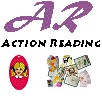CAN YOUR CHILD REALLY READ?
From:
LEARNING TO READ IS CHILD’S PLAY
By Jeanie Eller
You are very proud when your child brings home a great report card that shows that
your child is learning to read in school. So, how do so many children get to fourth
grade unable to read or graduate from high school unable to even read their own
diplomas? They do not learn to read in first grade and then are promoted all through
school and graduate still unable to read fluently and independently.
First graders memorize stories by looking at the pictures on the page. This is a
normal thing that children do, but it is not reading. The first grade teacher thinks
the child is reading. The child is very proud that he “can read” and the parents
are thrilled when the child reads the story to them. If you take the story book,
open it randomly to a page (without the child seeing it) cover up the picture so
only the words are visible, you may be shocked to find out that your child can not
read the words.
Find out if your child can read. Sit down with your child. Take something they have
not memorized (like a story in today’s newspaper or this article) and have your
child read it out loud to you. If your child has completed first grade they should
be able to fluently, accurately and independently read a story in the newspaper
and answer comprehension questions about the story. If they cannot, you need to
immediately teach your child to read. If you need help with teaching, contact www.ActionReading.com.
The Federal Government spent 2 Billion Dollars of our tax money to find out how
children learn to read. They came up with 7 principles of learning to read.
The first one is called Phonemic Awareness. Phonemic Awareness just means the awareness
that words are made up of sounds. A person (child or adult) must have this awareness
before they can move on to the next step of learning to read. When I taught illiterate
adults to read in two weeks for the Oprah Winfrey Show, they had to have this understanding
before they could learn to read.
The following are ways that you can teach these principles and your child can enjoy
learning to read.
- 1. Sing songs; play rhyming games and start making the connection of the beginning
sound of the child’s name with the symbol (letter) that represents that sound. For
example if the child’s name is Keelan, every time you see a letter K in a book or
on a sign, say, “Look, there’s your sound kuh. kuh”. Do not call it by its letter
name Kay. Call it by its sound, kuh.
- 2. Teach your child letter sounds not letter names. Teach your child the aah, buh,
cuhs first, not the ABCs. Letter names do not make words. Sea Aye Tea does not make
a word. When your child says the sounds of the letters, Cuh-aah-tuh the word “cat”
will come right out of their mouth. For help with teaching the sounds get the FUNdamentals
program. You can also make and play the following games.
- 3. Have your child make an Aah-Buh-Cuh Book. Take a cheap scrapbook with white or
beige pages. At the top of each page write one letter. (Both capitol and lower case).
Let your child cut or tear pages out of magazines and paste them on the appropriate
pages. I also let my children have any duplicate photos. My son pasted a picture
of a friend at a party on the Dd page and said, “Dan Doherty dancing. Duh, duh,
duh”.
- 4. Aah-Buh-Cuh Bingo. Take a piece of paper and make 5 rows across and 5 rows down
to form 25 Bingo squares. Say a word that begins with each sound of the alphabet.
You can always leave out one. Have the child write the capital and lower case letter
for the sound. Then give the child Cheerios or M&Ms to use for markers. Say a word
that begins with a sound and the child will find that sound and put the marker on
it. When they have a straight line across, down or diagonally they say “Aah-Buh-Cuh”
and they get to eat that row.
-
5. Aah-Buh-Cuh Checkers. Take a cheap checkerboard and write the letters in random
order with a black marker. Each time the child moves apiece they say the sound they
are moving to. If they forget or say the wrong sound, they lose a turn.
Jeanie Eller has been a classroom teacher for over 36 years. She trains teaches
all over the country. She taught illiterate adults to read in two weeks for the
Oprah Winfrey Show. She has done over one thousand radio interviews on the subject
of illiteracy and the simple solution. She is the developer of the ACTION READING
FUNdamentals learn to read at home program. She can be reached at: 1-800-378-1046
or www.ActionReading.com
Index |
FUNdamentals | About our Company
| Order Form
www.ActionReading.com
Action Reading - 480-695-8376
|

